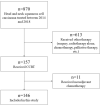Treatment Outcomes and the Safety of Chemoradiotherapy With High-Dose CDDP for Elderly Patients With Head and Neck Squamous Cell Carcinoma: A Propensity Score Matching Study
- PMID: 34888343
- PMCID: PMC8649661
- DOI: 10.3389/fsurg.2021.753049
Treatment Outcomes and the Safety of Chemoradiotherapy With High-Dose CDDP for Elderly Patients With Head and Neck Squamous Cell Carcinoma: A Propensity Score Matching Study
Abstract
Objective: We aimed to compare the outcomes and safety of chemoradiotherapy (CRT) between elderly and non-elderly patients with head and neck squamous cell carcinoma (HNSCC). It is difficult to assess the causal effect of age because of possible differences in general conditions among individuals. Therefore, we adjusted the background factors of elderly and non-elderly patients using propensity score matching (PSM). Methods: A total of 146 patients with HNSCC who received CRT were divided into an elderly (≥70 years, n = 35) and non-elderly group (<70 years, n = 111). Pre-treatment characteristics, including the performance status, Charlson comorbidity index, body mass index, primary site, and TNM stage were adjusted by PSM. We compared the outcomes and safety of CRT with high-dose single-agent cisplatin (CDDP) as well as outcomes following recurrence between the groups, before and after PSM. Results: The total dose of CDDP administered during CRT was significantly lower in the elderly group before PSM. However, it became comparable to the non-elderly group and adverse events did not differ between the groups following PSM, resulting in a comparable CRT completion rate. Overall-, disease specific-, and progression-free survivals of elderly patients were comparable to those of non-elderly patients following PSM. In contrast, elderly patients with recurrence could receive fewer salvage treatments than their non-elderly counterparts, resulting in worse survival. Conclusions: CRT with high-dose CDDP is safe and effective for the treatment of elderly patients with HNSCC. However, salvage treatments can be rarely conducted for elderly patients with a recurrence, considering a deterioration of their general condition.
Keywords: chemoradiotherapy; elderly patients; head and neck squamous cell carcinoma; high-dose single-agent cisplatin; propensity score matching.
Copyright © 2021 Omata, Ueki, Takahashi, Shodo, Yamazaki, Saijo, Ota, Togashi, Sato and Horii.
Conflict of interest statement
The authors declare that the research was conducted in the absence of any commercial or financial relationships that could be construed as a potential conflict of interest.
Figures



References
LinkOut - more resources
Full Text Sources
Research Materials
Miscellaneous

